Understanding the Complex Colors of Ruby Gems
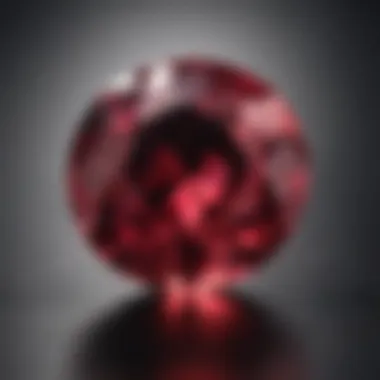
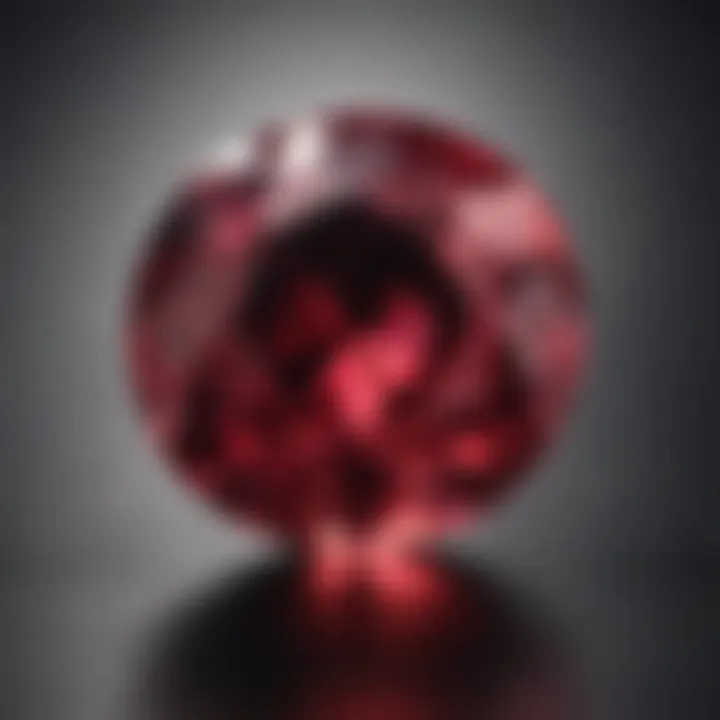
Intro
The intricate nature of ruby gem color is both fascinating and complex. This section aims to shed light on the essential characteristics of gemstones, particularly rubies. By exploring their definitions and classifications, we establish a foundational understanding of what makes ruby color so captivating.
Gemstone Overview
Definition and Characteristics
A gemstone is a precious or semi-precious stone that is used in jewelry and ornamentation. Rubies, specifically, are a variety of corundum, which is a crystalline form of aluminum oxide. Their vibrant red color is primarily due to the presence of chromium. Rubies are celebrated for their hardness, ranking 9 on the Mohs scale, making them second only to diamonds in durability.
Rubies can exhibit various hues, often classified into distinct categories based on color saturation and temperature. The most valuable rubies show a pure red hue with a hint of blue, known for their vividness and depth. Other colors may lean toward pink or even brownish tones, affecting their desirability and market value.
Classification of Gemstones
Gemstones are broadly classified into two categories: precious and semi-precious. Rubies fall under the precious gemstone category, alongside diamonds, emeralds, and sapphires. Within various gemological frameworks, they are further classified by factors such as:
- Color: As discussed, rubies are primarily red, with variations impacting value.
- Clarity: This refers to the presence of inclusions and how they affect the aesthetic.
- Cut: The way a ruby is fashioned can enhance its beauty and brilliance.
- Carat weight: Larger rubies are rarer and often more valuable.
Historical Significance
Ancient Uses and Cultural Importance
Historically, rubies have been prized across cultures for their beauty and perceived protective properties. Ancient civilizations believed that rubies could safeguard their owners from harm. In many cultures, they were associated with royalty, symbolizing power and wealth. The deep red color represents blood and life, further intertwining rubies with various myths and beliefs.
Myths and Legends Surrounding Gemstones
Rubies are steeped in myths that elevate their status beyond mere adornments. One popular legend suggests that wearing a ruby makes the wearer invulnerable to ailments and brings prosperity. Other legends often connect rubies to the heart and emotions, imbuing them with meanings of passion and love.
Rubies have been used as talismans throughout centuries, believed to grant mystical benefits to the wearer.
Understanding the historical and cultural context around rubies deepens our appreciation for their captivating colors. The blend of unique geological properties and their esteemed position in human history continue to influence how we perceive and value these gemstones.
Understanding Ruby Gemstones
Understanding ruby gemstones is a cornerstone of appreciating their unique beauty and intrinsic value. Rubies are not only admired for their vivid colors but also for their historical significance and technological aspects. The array of hues, particularly the deep red shades, makes rubies a standout choice in jewelry and a coveted item among collectors.
The importance of examining ruby gemstones lies in the interplay of their formation, composition, and historical context. Each ruby is a product of specific geological conditions that impart its distinct attributes. Understanding these elements helps enthusiasts evaluate the quality, durability, and market demand of rubies effectively.
In the gemological world, the distinction between natural and treated rubies is significant. Natural rubies undergo minimal enhancements, whereas treated ones may be subjected to various processes to improve their color and clarity. Being informed about these treatments can affect consumer choices, making knowledge of ruby gemstones crucial for buyers.
Formation and Composition
Rubies are a variety of the mineral corundum, primarily composed of aluminum oxide. The presence of chromium is what gives rubies their iconic red color. When chromium ions substitute aluminum ions in the crystal lattice during the formation phase, they create a localized distortion that generates the rich red hue. This phenomenon is critical for understanding why rubies vary so much in color intensity and saturation.
The geological formation of rubies occurs primarily in metamorphic rocks. The intense heat and pressure over millions of years contribute to the crystallization of corundum. Additionally, rubies may also form in alluvial deposits, where they are eroded from their original source but retain their vivid attributes. Each ruby tells a story of its unique journey through the Earth's crust.
Historical Context
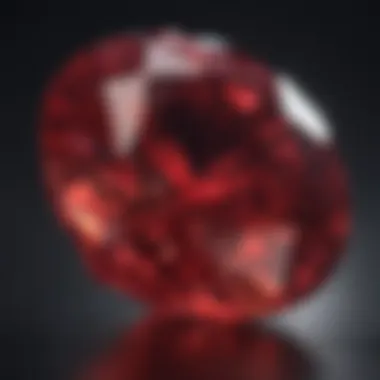
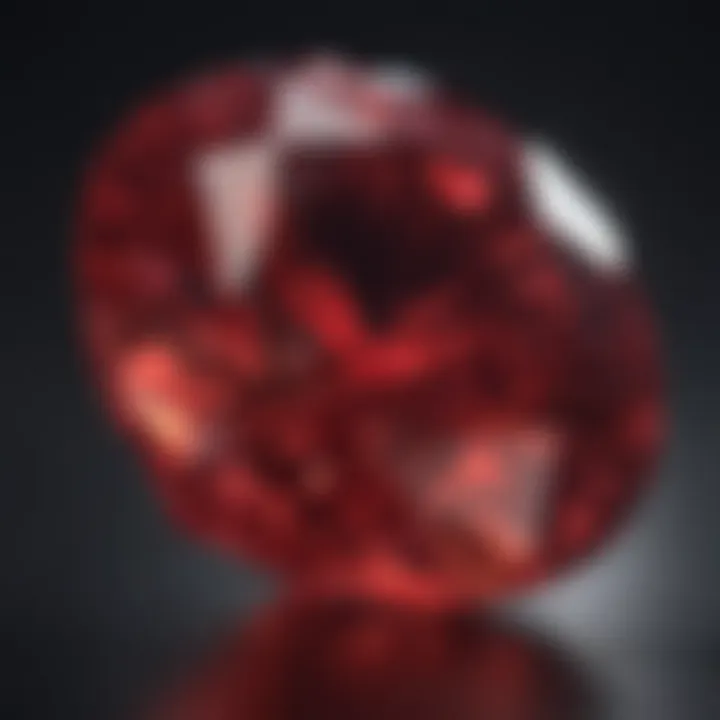
The allure of rubies dates back thousands of years, often intertwined with various cultures and beliefs. Historically, rubies were regarded as symbols of power and protection. In many ancient societies, they were thought to hold mystical properties that safeguarded their owners against harm, making them a popular choice for royalty and warriors.
In addition to their symbolism, rubies have been important in trade. The Silk Road facilitated the movement of gemstones, including rubies, between Asia and Europe, enhancing their availability and desirability. The historical context of rubies extends into modern times, where they continue to signify prestige and luxury in jewelry making.
Understanding the evolution of rubies helps to appreciate their value more deeply. Their transformation from ancient artifacts to modern symbols of love and passion reflects the enduring fascination with these gemstones. Observers not only admire their beauty but also the rich narratives that accompany each gem.
The Science of Color
Understanding the science of color is crucial when it comes to appreciating ruby gemstones. Color is not only a key aspect that determines the beauty of a ruby, but it also influences its market value. Factors such as hue, saturation, and tone play important roles in how a ruby is perceived. This section will explore fundamental concepts behind color, focusing on its relationship with light, perception, and scientific applications in gemology.
Color Theory Basics
Color theory encompasses the principles of how colors interact, how they are classified, and how our brains perceive them. In gemology, the attributes of color can significantly affect a ruby's allure.
Hue refers to the basic color itself, such as red, which is the primary hue for rubies. Saturation describes the intensity or purity of the color. A highly saturated ruby, with a vivid and undiluted red, is typically more desirable. The tone refers to the lightness or darkness of a color.
When evaluating rubies, gemologists often reference these attributes in combination. A well-formed understanding of these fundamental concepts is beneficial for collectors, designers, and enthusiasts alike. Moreover, knowledge of color theory can help one identify treatments or enhancements applied to rubies to improve their color.
Light and Perception
Light plays a pivotal role in how we perceive color. When light strikes a gemstone, it can either be absorbed, transmitted, or reflected. The way light interacts with a ruby affects its appearance dramatically. Different light sources, such as daylight versus incandescent light, can give the same ruby gemstone a very different look.
Our visual system interprets light rays, comprising various wavelengths, as different colors. For instance, the ideal ruby reflects light predominantly in the red wavelengths. However, imperfections in the stone or variations in its surroundings can influence our perception of its color. Factors like viewing angle and surrounding colors can create discrepancies in what is seen.
Spectroscopy in Gemology
Spectroscopy provides insights into the color of rubies through scientific analysis. This technique involves studying the spectrum of light absorbed by a gemstone. Each gemstone has a distinct absorption spectrum based on its chemical composition. For rubies, the presence of chromium as a chromophore gives rise to their striking red color.
Using instruments like the spectroscope, gemologists can determine color variations and identify enhancements or treatments. This tool is invaluable in distinguishing natural rubies from synthetics or imitations. In the gem market, authenticity and quality often rely on such scientific assessments.
Understanding the science of color not only deepens appreciation for rubies but also assists in making informed decisions in buying and selling these valuable gems.
Factors Influencing Ruby Color
The color of rubies stands as one of the most significant characteristics in gemology. Understanding the factors that influence ruby color provides insights not only into the gem itself but also into its market value and desirability among collectors and enthusiasts. The hue, tone, and saturation of a ruby can be affected by several elements, which warrant careful examination. It is paramount to grasp these factors to fully appreciate the complexities behind ruby gemstones.
Chromophores and Color Variations
Chromophores are atoms or molecules in a gemstone that absorb certain wavelengths of light, causing specific colors to be displayed. In rubies, the primary chromophore is chromium, which is responsible for the red hue. The amount of chromium present in the crystal structure can lead to variations in color. Indeed, rubies with higher concentrations of chromium tend to display a richer, more vivid red, while those with less may exhibit a more pinkish tone.
Accurate identification of chromophores allows gemologists to classify rubies and understand their value. Moreover, other trace elements like iron and titanium can influence not only the color but also the transparency and intensity of the red hue. Awareness of these variations is crucial for identifying high-quality rubies and advising potential buyers on their value.
Cut and Its Effects on Color
The cut of a ruby significantly impacts the way color is perceived. This involves how the gem is shaped, polished, and faceted. A well-executed cut can enhance the play of light within the gemstone, which may intensify its color. For example, a deep cut may enable greater light reflection and accentuate the brilliant red of the ruby.
Although the cut is subjective, it remains a critical aspect for collectors and jewelers when considering the aesthetic appeal of a ruby. Different cuts can lead to different visual outcomes. In some cases, cheaper rubies may have a less favorable cut that diminishes their color potential, making it vital to view them in different lighting conditions before making a purchase.
Inclusions and Clarity
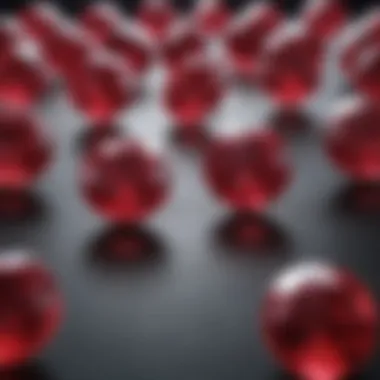
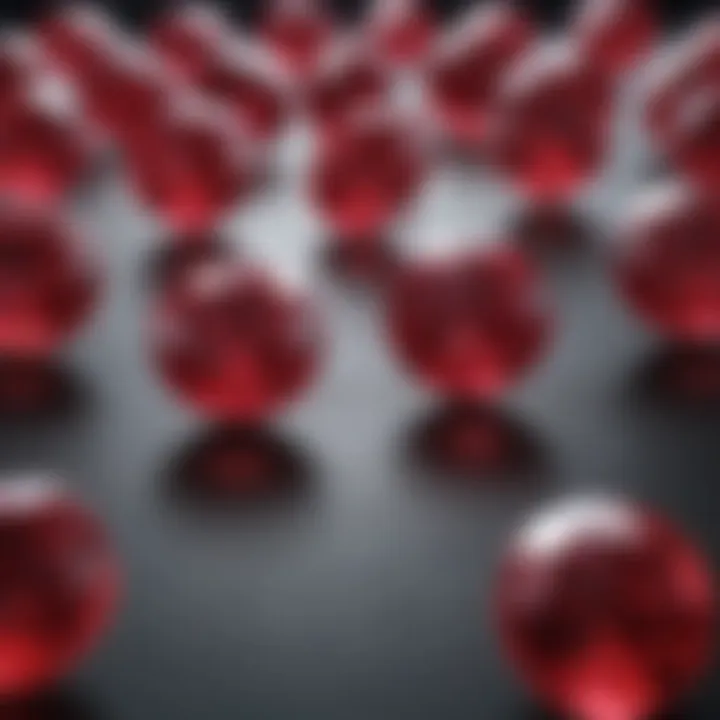
Inclusions are natural characteristics found within the ruby that can affect clarity and subsequently its color perception. Common inclusions include minerals like rutile, which may create silk-like effects in the stone. While inclusions can detract from clarity, they also can offer uniqueness to each ruby. Interestingly, certain inclusions don’t negatively impact value significantly if they contribute to an overall pleasing appearance.
Clarity is assessed on a spectrum, and rubies that exhibit fewer inclusions are generally more desirable. However, some buyers might favor stones with visible inclusions as they can add character. For example, the presence of a fingerprint inclusion can be seen as a natural signature of the gemstone, which adds to its story.
Understanding how chromophores, cut, and inclusions shape a ruby's color can significantly enhance each buyer's experience and aid in making informed decisions in the market.
Overall, these factors interplay to influence the color of rubies profoundly. Familiarity with these elements provides a deeper appreciation for not only the gemstone's beauty but also its valuation in a competitive market.
Grading Ruby Color
Grading ruby color is an essential aspect of gemology that directly influences the value and desirability of rubies. The grading system provides a standardized way to assess and compare colors, enhancing communication among gemologists, retailers, and customers. Understanding the grading criteria helps to determine market prices, making it a vital consideration for anyone involved in the ruby market.
The perception of a ruby's color plays a significant role in its appeal. Factors such as hue, tone, and saturation are crucial in grading. Each of these components affects how the gem is viewed, which in turn impacts consumer choices and investment potential. Grading not only helps potential buyers make informed decisions but also allows sellers to justify pricing based on objective criteria instead of subjective opinions.
The GIA Color Grading System
The Gemological Institute of America (GIA) has established a recognized standard for grading ruby color, which consists of three primary components: hue, tone, and saturation.
- Hue refers to the basic color of the ruby, typically varying from purplish-red to red.
- Tone describes the lightness or darkness of the color, categorized from very light to very dark.
- Saturation indicates the intensity or vividness of the color, ranging from dull to vivid.
The GIA system uses detailed nomenclature to assign grades, which helps to ensure consistency across the industry. A ruby that is graded as "vivid red" is significantly more valued than one categorized as "light red." This provides clarity in transactions and assessments, allowing consumers to understand what they are purchasing.
Factors of Tone and Saturation
Tone and saturation are critical factors that affect the overall appearance and value of a ruby. A ruby with high saturation and an optimal tone will exhibit a striking color that is captivating to the eye.
- High Saturation: Rubies with higher saturation levels are deemed more desirable. Such rubies appear vibrant and possess a rich color, making them highly valued by collectors and buyers alike.
- Tone's Role: The tone must be appropriate—if a ruby is too dark, its beauty may be lost, while one that is too light may not exhibit the depth of color expected.
Understanding the interplay between tone and saturation can guide consumers when evaluating rubies. A well-graded ruby will strike a balance between these two aspects, providing a jewel that can truly shine.
Color Descriptors in the Market
In the marketplace, color descriptors play a significant role in influencing consumer perceptions and decisions. Sellers often use terms such as "blood-red," "pigeon’s blood," and "rich red" to characterize the hue of their rubies. These descriptors not only reflect the color but also evoke an emotional response among buyers.
- Emotional Appeal: Words like "pigeon’s blood" suggest a specific, sought-after hue that garners higher prices due to its allure and rarity.
- Market Clarity: Descriptors help in creating clarity while differentiating rubies based on their color qualities.
Ultimately, understanding these descriptors and how they relate to grading standards can help consumers navigate the market with more confidence. Effective communication through grading fosters educated decisions and encourages appreciation for the nuances of ruby color.
Cultural and Historical Perspectives
Understanding the cultural and historical significance of ruby color is crucial in comprehending its overall value and appeal. Rubies, with their intense red hues, have captured human interest for centuries. They appear in various narrative forms across different societies, reflecting diverse meanings and societal contexts. This exploration reveals how ruby gemstones not only serve as aesthetic objects but also embody powerful symbols, often linked to emotions and status.
Symbolism of Ruby Color
Ruby red is often associated with passion, love, and power. In many cultures, red symbolizes vitality and energetic love. The deep scarlet color has traditionally represented protection, prosperity, and good fortune.
Many believe wearing a ruby can bring about positive changes. For instance, in some Eastern cultures, rubies are thought to provide both physical and emotional healing. Ancient Hindu texts refer to rubies as the "king of gemstones." They are linked with the planet Mars, symbolizing courage and spirituality.
This symbolism has permeated through history, influencing art, literature, and even architecture. The vibrant hue makes it a favored choice for royal insignias and haute couture. Additionally, in medieval Europe, the ruby's color was thought to indicate purity of spirit.
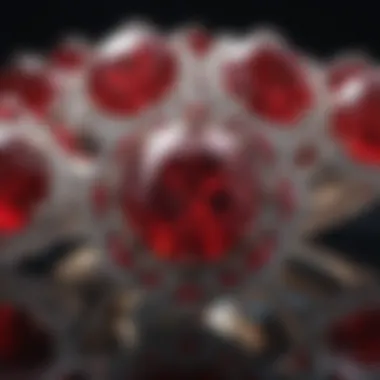
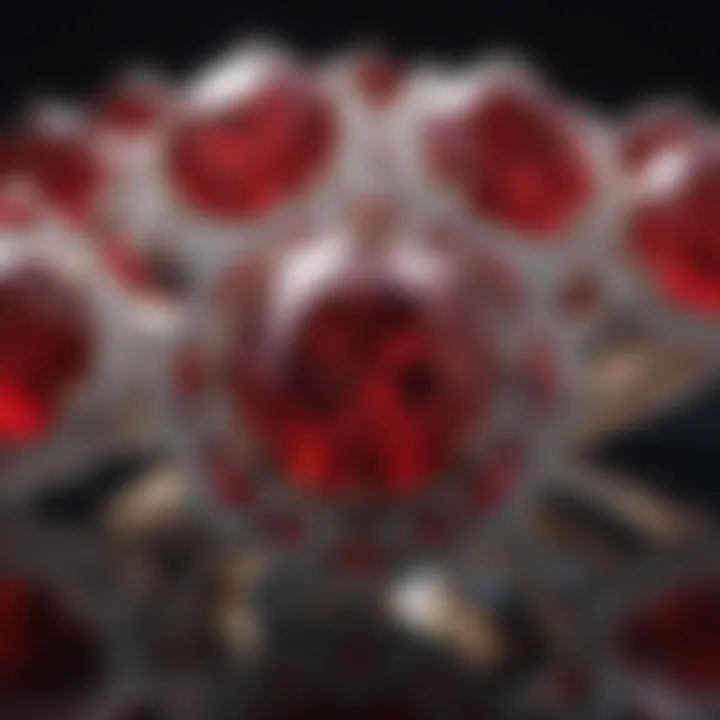
Ruby in Different Cultures
Rubies have varied meanings and values in different cultures, reflecting local traditions and beliefs.
- India: In India, rubies are considered one of the most auspicious gemstones. They are integral in traditional jewelry and often handed down as family heirlooms. Hindu mythology presents rubies as a means to attain prosperity.
- Southeast Asia: Countries like Myanmar still hold rubies in high esteem. The famous Burmese rubies are celebrated for their rich color and clarity.
- Western Cultures: In the West, rubies have often been a symbol of love and status. They are used in engagement rings and other significant jewelry pieces. The gemstone's deep red color is synonymous with romantic love, celebrated in popular culture and literature.
Adapting the understanding of ruby's cultural relevance can deepen appreciation for this gem. In modern times, rubies continue to represent wealth and elegance, often featured in high-value jewelry and collections.
"Ruby symbolizes passionate love and power, making it a timeless choice for jewelry that transcends cultures and eras."
By recognizing these cultural narratives, enthusiasts can engage with rubies on a more profound level, understanding their place not just as beautiful stones, but as storied artifacts woven into the fabric of human history.
Market Trends and Consumer Preferences
Understanding market trends and consumer preferences is crucial for comprehending the dynamics of ruby gemstones. The ruby market, like any precious gem sector, is influenced by cultural perceptions, economic conditions, and evolving tastes. Buyers are becoming more informed and discerning, largely due to the growth of online platforms that provide education and access to information about rubies.
Recent Developments in Ruby Market
Recent years have seen significant developments in the ruby market. Advancements in technology have improved the ability to evaluate gems. Enhanced tools for grading and identifying rubies have made it easier for consumers to ascertain quality. Synthetic rubies, created in laboratories, now offer cost-effective alternatives to natural stones. This development has shifted some consumer focus toward understanding the difference between natural and synthetic options.
Market preferences are also changing. There is an increasing demand for sustainable and ethically sourced rubies. Millennials and younger generations place significant value on the ethical implications of their purchases. As a result, jewelers are responding by adopting transparency in their supply chains. They are providing customers with information about the origins of their gemstones, making it a vital part of their business strategy.
Investment Value of Ruby Color
Rubies, especially those with vibrant color and clarity, are recognized as valuable investment pieces. The investment potential is closely tied to the hue of the stone. Deep red rubies with intense saturation are most sought after. The market for high-quality rubies continues to appreciate, indicating that they are a stable investment choice.
Investors and collectors are increasingly looking at rubies as a hedge against economic volatility. They recognize that gemstones can retain value better than traditional assets. Additionally, collector markets for particularly rare varieties, like the Burmese rubies, are thriving. These factors contribute significantly to the appeal of ruby color among investors.
Buying Tips for Consumers
For consumers interested in purchasing rubies, several factors should be considered to make an informed decision.
- Understand Color Grading: Familiarize yourself with the GIA grading standards. Pay attention to hue, tone, and saturation. A well-graded ruby can significantly affect its cost and desirability.
- Research Sources: Purchase from reputable dealers. Always ask about certification from reliable gemological institutes.
- Assess Treatment History: Many rubies undergo treatments to enhance their color. While treated stones can be beautiful, it's essential to know what treatments have been performed and how they affect the stone's value.
- Consider Long-Term Value: Think about the long-term potential of the ruby. Is it a piece for personal enjoyment or an investment? This decision will guide your purchase.
Overall, understanding market trends and consumer preferences in rubies leads to more informed choices and enhanced appreciation for these fascinating gemstones.
Care and Maintenance of Rubies
The significance of care and maintenance of rubies cannot be overstated. Gemstones, including rubies, are not just decorative pieces but also valuable investments. Proper care ensures that these exquisite gems maintain their beauty and value over time. Many factors contribute to the appearance of a ruby, such as its color, clarity, and brilliance. Therefore, regular maintenance is essential to preserve these characteristics.
Cleaning Methods
Cleaning rubies is a straightforward process. However, one needs to approach it with caution to avoid damage. Here are some recommended cleaning methods for rubies:
- Gentle Soap and Water: Mix warm water with a few drops of mild dish soap. Use a soft cloth or a brush with soft bristles, like a toothbrush, to gently scrub the surface. Avoid harsh chemicals that can erode the stone's surface.
- Ultrasonic Cleaners: These devices use high-frequency sound waves to create tiny bubbles that help in cleaning. While they can be effective, caution is necessary. Inclusions within a ruby can become loose, so this method is best used for rubies confirmed to be very durable.
- Professional Cleaning: For valuable pieces, consulting a professional jeweler is recommended. They have the right tools and expertise to clean rubies effectively without causing harm.
"A well-maintained ruby not only looks better but also holds more value in the gemstone market."
Storage Recommendations
Storing rubies properly is as important as cleaning them. Improper storage can lead to scratches or damage. Here are some essential tips for storing rubies:
- Separate from Other Jewelry: Always store your rubies away from other gemstones. Placing them together can lead to scratches or abrasions.
- Use Soft Pouches or Boxes: Keep each piece in a soft pouch or a dedicated box lined with fabric. This adds an extra layer of protection against scratches.
- Avoid Extreme Temperatures: Gemstones can be sensitive to temperature changes. Store them in an environment with stable temperatures and humidity to prevent any cracking or discoloration.
By adhering to these care and maintenance practices, one can ensure that their rubies remain a brilliant symbol of luxury and investment, continually enchanting all who behold them.







